Creating a hospitable environment for axolotls requires an understanding of their native habitats and specific needs. As fully aquatic salamanders, axolotls have distinct requirements that differ from many other aquarium inhabitants. From choosing the right substrate to maintaining optimal water conditions, every aspect of their tank setup plays a vital role in their well-being.
In this guide, we’ll outline the essentials of an axolotl tank setup, ensuring your aquatic friend has a safe and comfortable home.
A Quick Overview of the Axolotl
| Characteristic | Axolotl |
| Scientific Name | Ambystoma mexicanum |
| Common Names | Axolotl, Mexican walking fish, Mexican salamander, or Mexican axolotl |
| Family | Ambystomatidae |
| Origin | Initially discovered in various lakes, including Lake Xochimilco beneath Mexico City. |
| Diet | Carnivore |
| Care Level | Intermediate |
| Activity | Low |
| Lifespan | 10-15 years |
| Temperament | Peaceful |
| Tank Level | Bottom |
| Minimum Tank Size | 20 gallons |
| Temperature Range | 59 – 73°F (15 – 23°C) |
| Water Hardness | 125-250ppm (7-14deg) |
| pH Range | 6.5 – 8.0 |
| Filtration/Water Flow | Low |
| Water Type | Freshwater |
| Breeding | Egg-layer |
| Difficulty to Breed | Intermediate |
| Compatibility | Species-only tank or community tank |
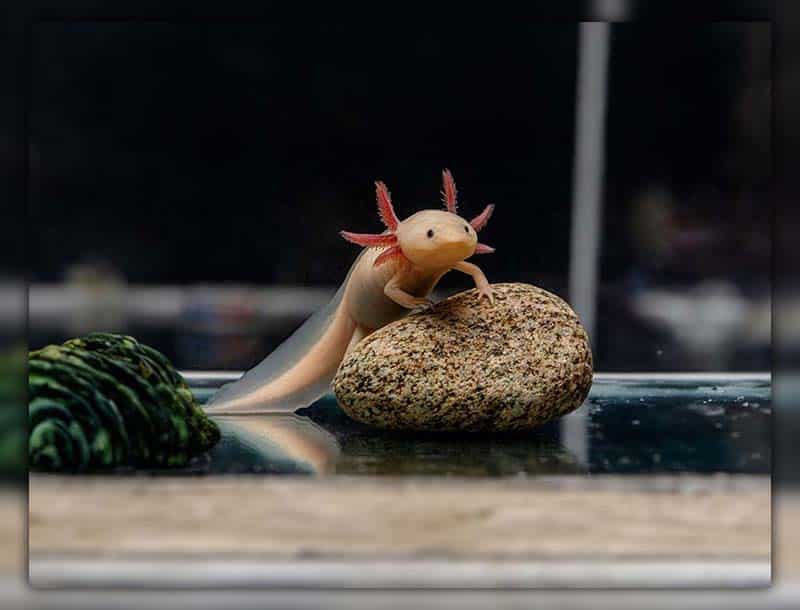
Axolotls are creatures that come out mostly at night and are a bit shy. They eat both small animals and plants. What’s really cool about them is that they can grow back parts of their body like arms, tails, and even some of their insides.
These axolotls look a bit like baby amphibians their whole lives. They have frilly things outside their bodies for breathing, a long tail, and eyes without eyelids. During the day, they like to hide in caves or under rocks, and at night, they come out to find food.
They eat things like worms, little bugs, tiny crabs, and small fish. Their special power to grow back body parts comes from their ability to make new cells from special cells in their body.
People like keeping axolotls as pets because they’re not too hard to take care of, and they can live in a fish tank for a long time.
Axolotl Behavior
In terms of behavior, axolotls reproduce via external fertilization, with the female laying eggs in a clutch that hatch into larvae after approximately 2-3 weeks. They boast an average lifespan of 10-15 years. Sadly, they face conservation challenges, being a threatened species due to habitat loss and pollution.
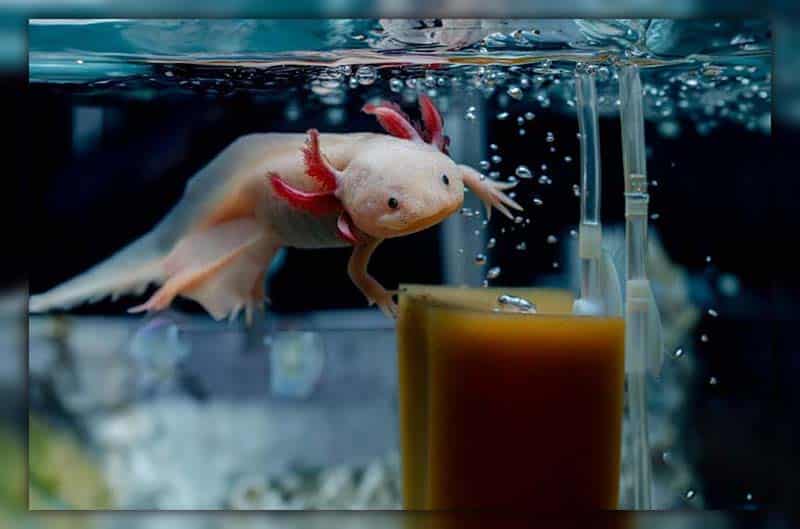
Axolotl Temperament
Regarding temperament, axolotls are generally gentle and amiable creatures. While not typically aggressive towards humans or other animals, they can display territorial behavior, especially if space is limited. Shy by nature, they may hide when approached, but over time, they can become more comfortable with human presence and may even approach the tank’s side to greet their owners.
Axolotl Tank Size Requirements
Discover the essential requirements for creating a comfortable and thriving habitat for your axolotls:
Minimum Tank Size for Axolotls
The minimum tank size for a single axolotl is 20 gallons. However, it’s advisable to opt for a larger tank if possible. Axolotls are active swimmers and need ample space to move. A good rule is to add 10 gallons of water for each additional axolotl.
Ensure the tank is long and deep rather than tall, maintaining a 2:1 length to depth ratio. This is important as axolotls are bottom-dwelling creatures and require sufficient swimming space at the tank’s bottom.
Best Tank Size for Axolotls
Ideally, aim for a tank size of at least 40 gallons. Providing a larger tank allows axolotls to move freely and find secure hiding spots. Adequate space promotes their well-being and prevents stunted growth or health issues. A tank of this size also accommodates plants and decorations while leaving ample room at the top. It’s recommended to leave some space at the top of the tank and install a robust filtration system, like a canister filter, to maintain water quality.
Best Tank Size for Two or More Than One Axolotl
Housing two or more axolotls requires careful consideration. For a pair or more, a tank size of at least 55 – 75 gallons is recommended. Anything below 55 gallons is not suitable as it may cause overcrowding and behavioral issues. Axolotls tend to be solitary creatures, and overcrowding can stress them. If you intend to keep other fish with your axolotls, choose fish of similar size to avoid them becoming prey to your axolotls. However, it’s advisable to avoid overcrowding for the well-being of all inhabitants and to reduce the need for frequent tank cleaning.
Axolotl Tank Setup (Complete Guide)
Tank Setup
Setting up the tank for your axolotls is a crucial step to ensure their well-being and happiness.
The Tank
The size of the tank you choose for your axolotl is crucial. While some pet stores may suggest a 10 gallon tank for young axolotls, this is not ideal for fully grown adults. Axolotls generate a fair amount of waste, and in smaller tanks, water quality can fluctuate significantly, affecting your pet’s health.
To ensure a healthier life for your axolotl, it’s best to start with a tank of at least 20 gallons for a young axolotl and consider upgrading to a 40-gallon tank as they grow. Larger tanks offer more water volume, which helps stabilize water conditions over time.
Substrate Considerations
When it comes to choosing the ideal substrate for your axolotl tank, several critical factors must be considered to ensure the well-being of your aquatic companions. Here’s what you should keep in mind:
- Particle Size: Axolotls are bottom-dwelling creatures with a penchant for foraging in the substrate. It’s imperative to select a substrate with particles large enough to prevent ingestion, which can lead to serious health issues. As a general guideline, opt for a substrate that is at least three times the size of your axolotl’s head.
- Smoothness: Axolotls possess delicate skin, making it essential to choose a substrate that is smooth and devoid of sharp edges or rough surfaces. A gentle, skin-friendly substrate ensures your axolotls remain unharmed while exploring their habitat.
- Cleanliness: Axolotls are known for their significant waste production, underscoring the importance of selecting an easy-to-clean substrate. Steer clear of porous or challenging-to-vacuum substrates to maintain a pristine tank environment.
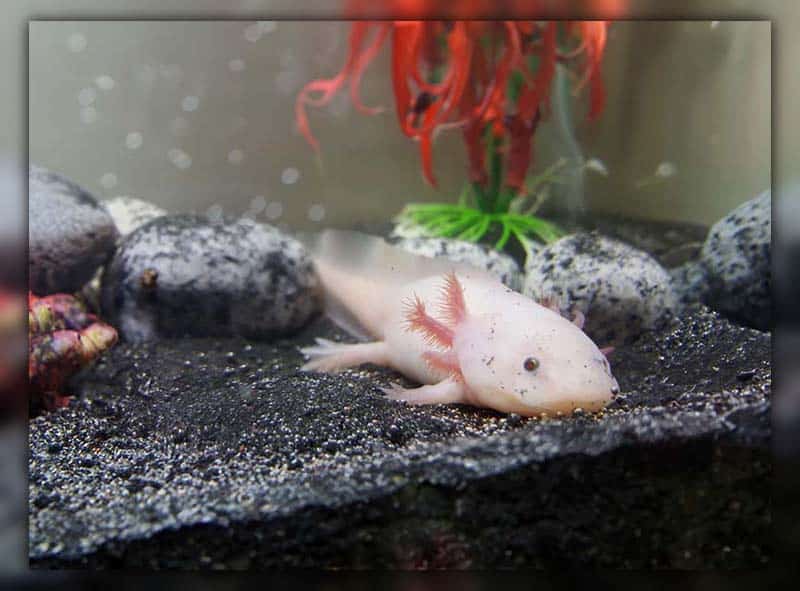
Popular Substrate Options for Axolotls:
- Sand: Sand is a favored choice for axolotl tanks due to its soft texture and ease of cleaning. However, it’s crucial to select a sand type that isn’t overly fine, as fine particles can be ingested, posing potential health risks.
- Gravel: Gravel is another viable option for axolotls, provided you choose gravel with sufficiently large particles to prevent ingestion. Avoid gravel that contains small or sharp rocks to ensure the safety of your axolotls.
- Bare Bottom: Some axolotl keepers opt for a bare-bottom tank. While this substrate type is the easiest to clean, it can be more challenging to maintain stable water parameters. Careful monitoring of water conditions is essential when using a bare bottom.
Tank Decorations
While axolotls are known for their low-maintenance care, providing them with a well-decorated tank can significantly enhance their quality of life. Tank decorations offer hiding spots, opportunities for exploration, and mental stimulation. Here’s what you should consider when selecting decorations for your axolotl’s habitat:
- Safety: Prioritize safety above all else. All decorations must be smooth and devoid of sharp edges or rough surfaces. Axolotls have delicate skin, making them susceptible to injuries from sharp objects.
- Size: Decorations should be appropriately sized to prevent your axolotl from accidentally swallowing them. A reliable rule of thumb is to choose decorations that are at least three times the size of your axolotl’s head.
- Non-Toxicity: Ensure that all decorations are made from non-toxic materials. Avoid decorations that are painted or coated with chemicals, as these can harm your axolotl and pollute the water.
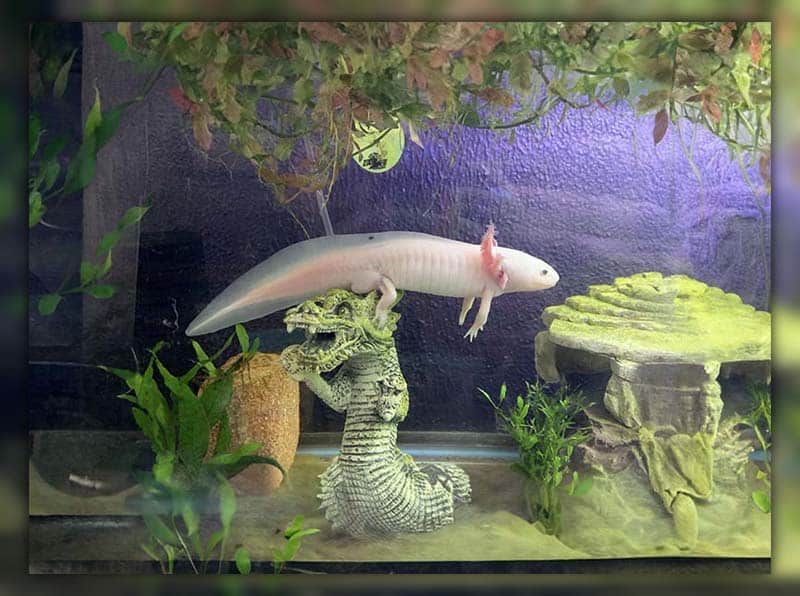
Examples of Suitable Axolotl Tank Setup Ideas:
- Rocks and Caves: Rocks and caves serve as essential hiding places, providing your axolotls with a sense of security. Opt for rocks and caves that are smooth and free of sharp edges.
- Pic 4
- Plants: Live plants not only improve water quality but also offer additional hiding spots. Choose plants that are safe for axolotls to nibble on, such as Java fern, Anubias, and Amazon sword.
- Artificial Plants: For those who prefer low-maintenance options, artificial plants are a convenient choice. Ensure they are made of soft materials and lack sharp edges.
- Hides: Various hides are available, including PVC pipes, terracotta pots, and ceramic caves. Select hides that are adequately spacious for your axolotl to comfortably enter and exit.
Filtration System
An effective filtration system plays a pivotal role in eliminating waste and harmful substances from the water. While various filtration options are available, canister filters are widely regarded as the optimal choice for axolotls. They excel at efficiently removing waste and debris from the water while operating quietly.
When choosing a canister filter for your axolotl tank, consider the following factors:
- Size: Ensure the selected canister filter is adequately sized to handle the volume of water in your tank.
- Flow Rate: Opt for a filter with a flow rate appropriate for the tank’s size and the number of axolotls residing within it.
In addition to a canister filter, it is highly recommended to incorporate an air pump and airstone into your axolotl tank. This supplementary aeration helps oxygenate the water, creating a more natural and comfortable environment for your axolotls.
Lighting
Axolotls are nocturnal creatures, which means they don’t require bright lighting. In fact, excessive light can stress them out. A recommended lighting schedule is to provide 12 hours of light and 12 hours of darkness each day to mimic their natural day-night cycle.
There are various lighting options for axolotl tanks, including fluorescent lights, LED lights, and natural light from a window. However, it’s crucial to avoid using lights that are too bright or emit heat, as this can lead to elevated water temperatures.
If you choose natural light from a window, make sure to position the tank in a location where it won’t receive direct sunlight. Direct sunlight can cause the water temperature to rise excessively and encourage algae growth in the tank.
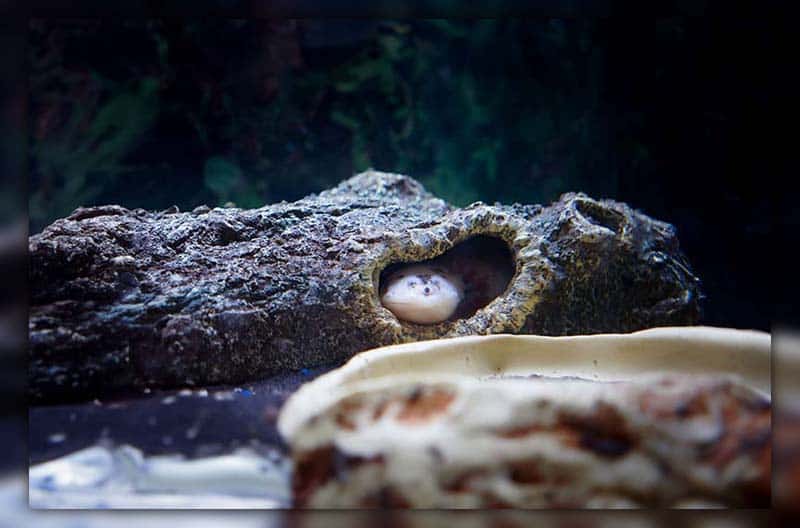
Water Parameters
To keep your axolotls healthy and thriving, it’s crucial to provide a stable aquatic environment. Axolotls are highly sensitive to changes in water parameters. Here are the ideal water parameters you should aim for:
- Temperature: Maintain a temperature range of 60-68 degrees Fahrenheit (15-20 degrees Celsius) in the axolotl tank.
- pH: Keep the pH level within the range of 6.5-8.0.
- Ammonia: Ensure that ammonia levels remain at 0 ppm, as any presence of ammonia can be harmful to axolotls.
- Nitrite: Maintain nitrite levels at 0 ppm, as elevated nitrite levels can also have adverse effects on axolotls.
- Nitrate: Aim for nitrate levels between 0-20 ppm.
- General Hardness (GH): Keep general hardness (GH) in the range of 7-14 dH.
- Carbonate Hardness (KH): Maintain carbonate hardness (KH) between 3-8 dH.
Regularly test the water parameters in your axolotl tank using water testing kits available at most pet stores. If any of the parameters fall outside the ideal range, take appropriate measures to adjust them. This may involve performing a water change or using a water conditioner.
Water Temperature
Axolotls are cold-water amphibians, and they thrive in water temperatures between 60 and 68 degrees Fahrenheit (15 and 20 degrees Celsius). Water temperatures above 72 degrees Fahrenheit (22 degrees Celsius) can cause axolotls to become stressed and ill.
There are a few different ways to keep the water temperature in your axolotl tank cool. One way is to use a fan to blow air over the surface of the water. Another way is to use a chiller, which is a device that circulates cool water through the tank. If you live in a warm climate, you may need to use both a fan and a chiller to keep the water temperature for Axolotls cool enough.
Tank Mates
While axolotls are typically peaceful in nature, they are also opportunistic predators. They have an appetite for anything that can fit into their mouths, and that includes other axolotls. To maintain a harmonious aquatic community, it’s essential to exercise caution when choosing tank mates for your axolotls.
Here is a list of compatible tank mates that can coexist with axolotls:
- White Cloud Mountain Minnows
- Guppies
- Zebra Danios
- Apple Snails
- Small Shrimp
- Cardinal Tetras
- Endler’s Livebearers
These species are generally safe companions for axolotls due to their smaller size and peaceful behavior. However, it’s crucial to monitor interactions between different species to ensure that all tank inhabitants thrive in a harmonious environment.
Tank Maintenance
Axolotls thrive in a clean and well-maintained tank environment. Here are key practices to ensure their optimal health and comfort:
- Regular Water Changes: Conduct weekly water changes of approximately 25-50% to maintain good water quality. Axolotls are highly sensitive to water conditions, making regular changes essential for their well-being.
- Substrate Vacuuming: Perform routine vacuuming of the substrate to eliminate waste accumulation. Keeping the substrate clean contributes to a healthier tank environment for your axolotls.
- Cleaning Tank Decorations: Clean tank decorations regularly to prevent bacterial growth, as axolotls may nibble on them. Ensure decorations remain free of waste and debris for a safe and hygienic habitat.
- Water Parameter Testing: Consistently monitor and test water parameters, including pH, ammonia, nitrite, and nitrate levels. Ensure these parameters are within the appropriate range to support your axolotl’s health and well-being.
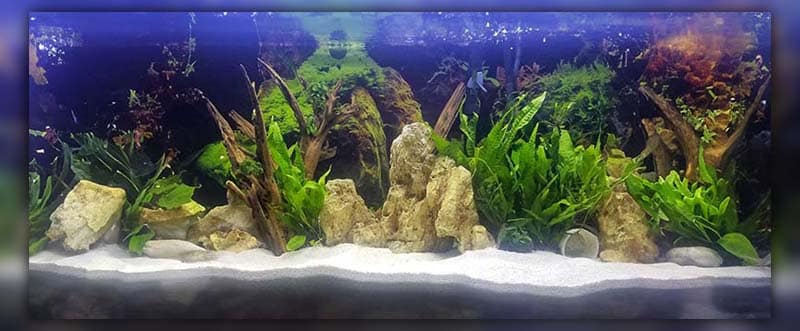
In wrapping up our exploration into the world of axolotls and their ideal habitat, we’ve uncovered essential insights into Axolotl tank setup requirements. From size specifications to temperature and water necessities, we’ve got you covered in ensuring a thriving environment for your axolotl companions.
For more in-depth guides, tips, and expert advice on creating exceptional aquatic spaces, do explore more of our enlightening blogs at National Park Aquarium. Let’s continue to unravel the mysteries of underwater worlds together! Stay curious and keep discovering with National Park Aquarium.




